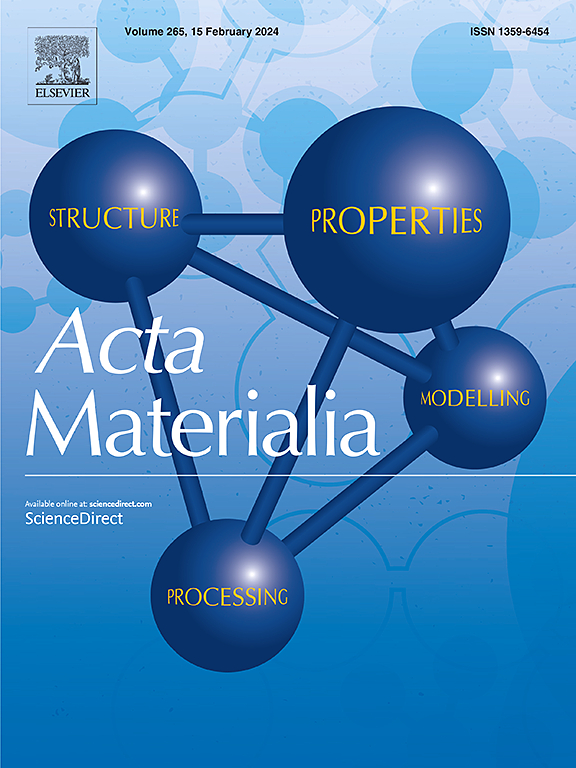烧结后退火Nd-Ce-Fe-B磁体中REFe2相的温度依赖性演化及相关矫顽力响应
IF 9.3
1区 材料科学
Q1 MATERIALS SCIENCE, MULTIDISCIPLINARY
引用次数: 0
摘要
控制REFe2 (RE = 稀土)晶间相对于开发可媲美传统Nd-Fe-B磁体性能的富ce Nd-Ce-Fe-B磁体至关重要。本文系统地研究了Ce12.8(Pr, Nd)19.2Fe65.33MbalB0.9多主相磁体(Ce/total RE = 40 wt.%)在烧结后大范围退火(300-950℃)中REFe2相的演化过程。在扫描矫顽力的温度依赖性后,420°C和650°C的两个退火温度产生更高的矫顽力,但通过不同的机制。420℃退火有利于REFe2相的形成,部分晶界(GB)增厚。650℃退火导致REFe2相分解,并在炉内冷却时重新形成。事实上,通过水淬、风冷和炉冷对650°C的冷却进行比较表明,后一种(最慢的)冷却速度产生的REFe2相分数最大为5.4 wt.%。值得注意的是,这种REFe2相的形成伴随着Ce从RE2Fe14B基体壳层中排出,以及Nd向RE2Fe14B基体壳层的浸润。结果表明,在650℃的炉冷样品中,基体壳中Nd和Ce的组分差异最大([Nd]壳- [Ce]壳 = 7.1 wt.%),产生的最大矫顽力为12.6 kOe。这项工作揭示了Nd - Ce - fe - b烧结磁体中REFe2相的温度依赖演化,以及Ce和Nd再分布的性质和动力学。本文章由计算机程序翻译,如有差异,请以英文原文为准。


Temperature-dependent evolution of REFe2 phase and correlated coercivity responses in post-sinter annealed Nd–Ce–Fe–B magnets
Control of the REFe2 (RE = rare earth) intergranular phase is of vital importance for developing Ce-rich Nd–Ce–Fe–B magnets that can rival the performance of conventional Nd–Fe–B magnets. Here we systematically investigate the evolution of the REFe2 phase in a multi-main-phase Ce12.8(Pr, Nd)19.2Fe65.33MbalB0.9 magnet (Ce/total RE = 40 wt. %) triggered by wide-range post-sinter annealing (300–950 °C). Following a scan of the temperature dependence of coercivity, two annealing temperatures of 420 °C and 650 °C yield higher coercivity, but via different mechanisms. 420 °C annealing facilitates the formation of the REFe2 phase, and partially thickened grain boundary (GB). 650 °C annealing results in the decomposition of the REFe2 phase, and its re-formation during furnace cooling. In fact, comparing cooling from 650 °C via water-quenching, air-cooling, and furnace-cooling demonstrates that the latter (slowest) cooling rate yields the maximum REFe2 phase fraction of 5.4 wt.%. Significantly, the formation of this REFe2 phase is accompanied by the expulsion of Ce from RE2Fe14B matrix shell, and the concomitant infiltration of Nd into the RE2Fe14B matrix shell. As a result, a maximum compositional difference between Nd and Ce in the RE2Fe14B matrix shell is recorded in the 650 °C furnace-cooled sample ([Nd]shell – [Ce]shell = 7.1 wt.%), yielding a maximum coercivity of 12.6 kOe. This work unveils the temperature-dependent evolution of the REFe2 phase in Nd–Ce–Fe–B sintered magnets, and the nature and kinetics of the Ce and Nd redistribution.
求助全文
通过发布文献求助,成功后即可免费获取论文全文。
去求助
来源期刊

Acta Materialia
工程技术-材料科学:综合
CiteScore
16.10
自引率
8.50%
发文量
801
审稿时长
53 days
期刊介绍:
Acta Materialia serves as a platform for publishing full-length, original papers and commissioned overviews that contribute to a profound understanding of the correlation between the processing, structure, and properties of inorganic materials. The journal seeks papers with high impact potential or those that significantly propel the field forward. The scope includes the atomic and molecular arrangements, chemical and electronic structures, and microstructure of materials, focusing on their mechanical or functional behavior across all length scales, including nanostructures.
 求助内容:
求助内容: 应助结果提醒方式:
应助结果提醒方式:


